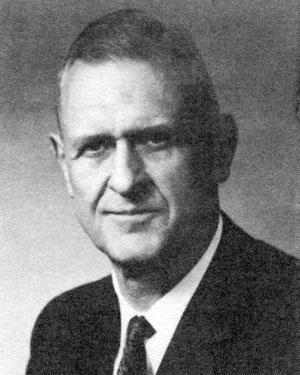
January 29, 2014
AASHTO Presidential Profile: Thomas F. Airis, District of Columbia

Thomas F. Airis, director of the District of Columbia's Department of Highways and Traffic, was elected the 61st president of the American Association of State Highway Officials in November 1972 at the association's annual meeting in Phoenix, Arizona. He would serve during a time of big changes for the association that included its shift from a highways-only focus to a multi-modal mission while still representing and promoting the priorities of the states at the national level.
"In making these changes, I think the Association is keeping abreast of the times and stepping into a role that is needed," Airis said at the end of his term as the last president of AASHO. "The emphasis now, as in the past, is on state officials."
Airis was born on May 2, 1906, in the town of Eau Claire, Wisconsin. He earned his degree in civil engineering from the University of Wisconsin. In 1929, Airis joined the U.S. Army Corps of Engineers in the Detroit District as a civil engineer. He remained there until 1943, serving in various capacities in river and harbor, airfield, flood control, and ordinance plants work.
During World War II, Airis served as an officer and troop commander in the U.S. Army Corps of Engineers in the Pacific Theatre. He was assigned to Greece after the war, and there supervised extensive road, airfield, and port construction programs throughout northern region of that country. During the Korean War just a few years later, he was recalled to active duty in the Army. He served during that time in Saudi Arabia, overseeing the construction of an airbase.
In 1954, Airis was made Area Engineer and in that role supervised construction projects for the U.S. segment of the Saint Lawrence Seaway. That large-scale effort was completed in 1959 and involved a considerable amount of work on locks, canals, ship channels, roads, and bridges.
In the same year that the Saint Lawrence Seaway was completed, Airis became deputy director of the District of Columbia's Department of Highways and Traffic. He became director of that agency in 1964.
As director, Airis became a central figure in discussions about construction of the Interstate Highway System that was very much in progress both locally and nationwide at that time and he frequently testified before Congress about those issues and others. Airis also found himself tackling the urgent traffic challenges that increasingly faced the city during that era.
Airis voiced support for the shared role that highways and mass transit could play in alleviating local traffic congestion, and he was instrumental in the efforts to begin building the region's Metrorail system. He was also a staunch advocate for more highways in the city, arguing strongly for that option in a variety of community meetings and other local forums.
Airis also found time to be active in AASHO, serving on the Transport and Personnel Development Committee and as First Vice President on the Executive Committee. As president, Airis spearheaded the assessment of long-term structural changes that led to renaming the association AASHTO at the November 1973 annual meeting and embracing what he called "the whole broad spectrum of transportation."
Airis's other achievements as president included emphasizing traffic safety. He likewise helped promote the perspective and priorities of the states with respect to the legislative measure that ultimately became the Federal-Aid Highway Act of 1973, which provided funding for existing Interstate routes and new urban and rural roads across the nation and also for a highway safety improvement program.
After leaving his job in the District of Columbia in 1974, Airis worked for an engineering consulting firm in the area over the next decade. He died on Aug. 7, 1991, in Edgartown, Massachusetts, at the age of 85.












